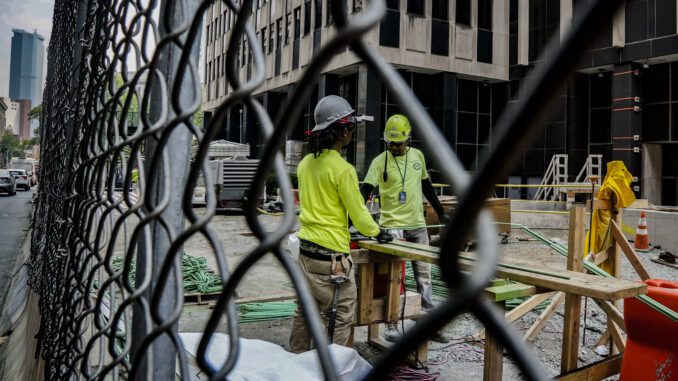
WASHINGTON, D.C. —The pace of hiring by businesses and government agencies in June — 209,000 added jobs — was the smallest monthly gain in 2 1/2 years. Yet it was still a healthy increase, enough to reduce the unemployment rate from 3.7% to 3.6%, barely above a half-century low. And it amounted to further evidence of an economy that has defied persistent forecasts of a recession.
The latest sign of economic strength makes it all but certain that the Federal Reserve will resume its interest rate hikes later this month after having ended a streak of 10 rate increases that were intended to curb high inflation.
Yet there were also signals in Friday’s government report that the job market is cooling to a more sustainable pace of growth — a trend that, if it continues, could reassure the Fed that its rate hikes are reducing inflation pressures without derailing the economy.
“This is kind of a Goldilocks report,” said Julia Coronado, president of MacroPolicy Perspectives, an economic research firm. “It’s a resilient labor market — not too hot, not too cool.”
The economy has been beset by high interest rates, elevated inflation and nagging worries about a possible recession resulting from the Fed’s aggressive efforts to quell price increases.
Several factors, though, are countering those headwinds and helping perpetuate hiring, which typically boosts consumer spending and propels the economy.
Industries that are particularly sensitive to higher borrowing costs — such as housing and car sales — appear to have adjusted to the Fed’s higher rates. To take one example: Mortgage rates have nearly doubled since the Fed began raising borrowing costs 15 months ago. But most of that increase had occurred by last fall. In recent months, housing has shown signs of rebounding, with sales and construction of new homes picking up.
And higher interest rates normally would be expected to spur job losses in construction and manufacturing. This time, the opposite has happened: Construction firms added 23,000 jobs last month, automakers 4,300. There are so few homes available that even reduced demand for housing is spurring more construction — and more jobs.
Likewise, despite sharply higher loan rates, auto sales have risen this year largely because of pent-up demand after years of reduced supply.
Construction companies are also benefiting from ongoing infrastructure spending by the Biden administration, and so are other industries.
Beyond all that, most of the U.S. economy is made up of services — from banking to restaurants to shipping and warehousing — that are much less affected by the Fed’s rate hikes.
The most visible sign that hiring is slowing is that fewer industries are actually adding jobs. Most of last month’s job growth came in three broad categories that are largely insulated from economic trends: State and local governments, health care providers and private education. Together, they added 133,000 jobs.
Because those sectors don’t depend on robust consumer spending as much as the rest of the economy does, their hiring gains don’t really reflect rising consumer demand — the main fuel for inflation.
By contrast, retailers, transportation and warehousing firms as well as temporary staffing agencies all cut workers. A loss of temp jobs can be an early signal that companies need less labor.
Dean Baker, senior economist at the Center for Economic Policy Research, noted that excluding government hiring, private-sector job gains totaled 149,000 in June, a pace that does not necessarily point to an overheating economy that would alarm the Fed.
“It’s hard to say that’s too fast,” Baker said. “That’s pretty much sustainable.”
The government’s report Friday also showed that the economy gained 110,000 fewer jobs in April and May than it had previously estimated. Over the past three months, job growth excluding government has averaged 196,000 a month, down from 317,000 a month a year ago.
A rate hike at the Fed’s meeting later this month is considered all but assured. Whether the Fed will hike again when it next meets in September is harder to foresee.
The central bank’s policymakers may take solace from the slowdown in hiring, particularly once they exclude government jobs, which don’t reflect the state of demand in the economy. Fed officials signaled last month that they envision as many as two additional quarter-point rate hikes before the year ends.
But Chair Jerome Powell has also said he hopes to engineer a so-called “soft landing,” in which the economy would slow enough to tame inflation but not enough to succumb to a recession.
Friday’s jobs report suggests that the Fed may achieve that often-elusive goal, economists said.
“The Fed is on track for a soft landing,” said Betsey Stevenson, an economics professor at the University of Michigan. “What they have to do is steer us the rest of the way down. We didn’t crash, but that doesn’t mean that we won’t crash.”
One factor that has supported the job market has been a rebound in the number of people looking for work. Many businesses say they’re seeing increased applications and are having an easier time filling jobs.
Higher inflation and an uncertain economic outlook appear to be drawing more people into the workforce. The proportion of Americans ages 25 through 54 — a category that filters out most students and retirees — who are working rose to 80.9% in June, above the pre-pandemic peak and the highest level in 22 years.
And legal immigration has rebounded after being restricted during the pandemic. Coronado estimates that immigrants are adding about 50,000 workers to the labor supply each month.
At the same time, the number of job openings dropped in May, a sign that demand for workers is gradually cooling.
